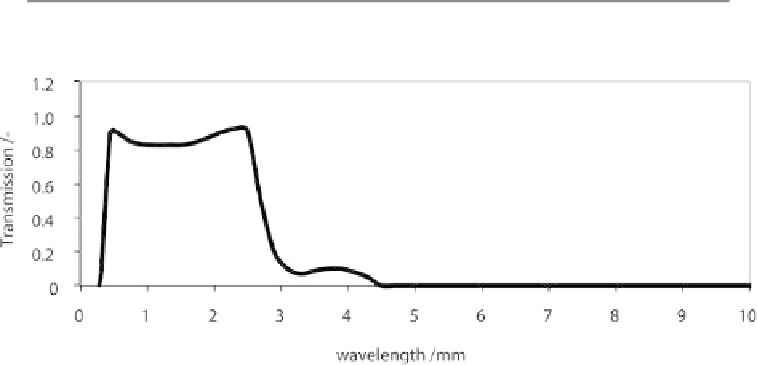Environmental Engineering Reference
In-Depth Information
Table 18.2.1
U values required to reach passive standard for different European climates
U values
Rome
Helsinki
Stockholm
/Wm
−
2
K
−
1
Passive building
Passive building
Passive building
Wall
0.13
0.08
0.08
Window
1.4
0.7
0.7
Roof
0.13
0.08
0.08
Ground
0.23
0.08
0.1
Mean
0.33
0.16
0.17
Figure 18.2.2
Wavelength-dependent transmittance of a single glazing.
18.2.1 Passive solar gains by glazing
Glazing is characterized by high transmittances for short-wave solar irradiance up to
wave lengths of 2.5
m and an impermeability to long-wave radiant heat emitted from
building components with a maximum intensity at wavelengths of around 10
µ
m, as
demonstrated by Figure 18.2.2. This transmission characteristic results in a greenhouse
effect and the conversion of solar irradiance by absorption in structural elements into
heat, the long-wave radiation proportion of which is not transmitted through the
glazing.
µ
18.3 TOTAL ENERGYTRANSMITTANCE OF GLAZING
Aside from the direct transmission of short-wave solar radiation with a transmittance
τ
, part of the irradiance is absorbed in the panes, as illustrated by Figure 18.3.1.
Heating the panes causes a heat flow towards the room, which contributes to the total
energy transmission factor (g-value). The absorption coefficient of single glazing can
be up to 50% for special sun-protection glazing. The secondary heat emission degree
q
i
is defined as the relation of the heat flow on the room side
Q
i
per square metre of
window area
A
w
to the impacting solar radiation
G.
The value of
q
i
is calculated by


Search WWH ::

Custom Search